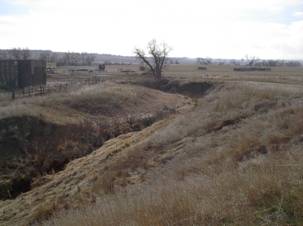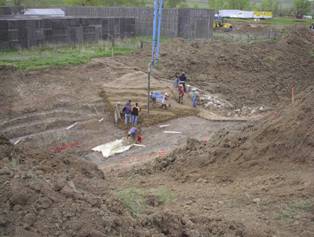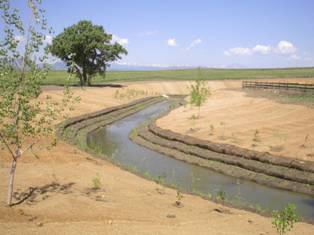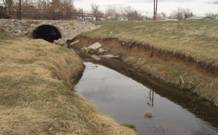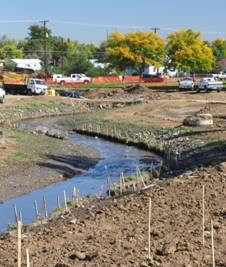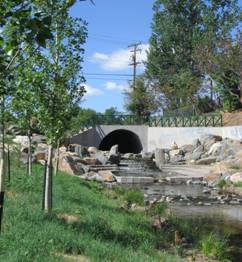
Two District Maintenance Projects ProfiledBy Dave Bennetts, Senior Project Engineer, Design, Construction & Maintenance Program
Rock Creek Restoration Project The primary goal for the project was to provide channel stability and enhancements while blending them into the natural environment. In order to accomplish this, two innovative techniques were used, sculpted concrete drop structures and low-flow channel soil wrapped lifts. Drop Structures The sculpted concrete was colored and shaped to mimic sandstone outcroppings. New to the process was texturing the wet concrete with a rubber stamping process that closely matched the patterns found in the rock outcroppings in the area. Six sculpted structures were constructed varying in height from two feet to eleven feet. On several of the structures, planting wells were installed and planted with native shrubs to soften the appearance of the structure. Soil Lifts
Revegetation and Restoration The project was completed in the spring of 2005 at a final cost of $800,000 and has been closely monitored by Boulder County Parks and Open Space and the District. Site maintenance has included selective weed control and re-seeding of upland areas that did not establish after the first growing season. Since the project was completed, the drainageway has seen several significant runoff events with no damage. The vegetation has established itself well and the site has flourished. The District will continue to monitor the project to evaluate the long term success of these two techniques.
Sanderson Gulch Project
They teamed up with the District and were a funding partner on the project. The District’s project goals included building two new drop structures, constructing headwalls at the upstream and downstream ends of culvert going under Florida Avenue to improve the hydraulics and safety, regrading the entire reach of the channel, and extensive tree and wetland planting efforts. The parks department project goals included 1100 feet of trail, a new trail crossing, an upgraded irrigation system, and adding several other park improvements such a park benches and picnic tables. Several aspects of this project were unique. The two new drop structures upstream and downstream of Florida Avenue were constructed using precast concrete blocks with exposed black aggregate in lieu of boulders. The drop structure upstream of Florida Avenue was constructed as an improved inlet with the concrete blocks forming the approach and drop into the inlet. The drop structure downstream of Florida Avenue used the precast concrete blocks to form a cascading stair approach to the plunge pool. Large boulders of varying sizes and shapes were placed to stabilize the structure for larger events. The boulders placement created pocket areas that were then planted with nativeIncised channel upstream of Florida Avenue shrubs and trees. Wing walls were constructed on both ends of the culvert with an architectural rail on top.
A 10-foot wide channel through the park was constructed to provide more sinuosity, reduce bank erosion, improve the channel hydrology, and to increase areas of vegetation for water quality. The outside bends of the channel were graded to a 6:1 slope to create pocket wetlands and were reinforced with coir biologs pre-planted with wetland plant material. This was the first project the District had used the pre-planted biologs. The plant material was fully rooted in the biologs that were then placed in small groves in the channel bottom. This process allows the plant material to immediately root and establish itself. Approximately 1320 lineal feet of biologs were installed as part of this project. The inside bends of the channel were graded to a 4:1 slope and protected with a biodegradable erosion control blanket planted with native grasses and shrubs.
Extensive planting was completed once the final grading was complete. This included 112 trees, 325 shrubs, 4570 plant plugs and willow whips, and upland seeding. The upgraded irrigation system installed by the parks department was used to help establish the new vegetation. The project was completed in the spring of 2006 at a cost of $940,000.
|
||||||||||||||||||||
